Does the New Intel Power Compact Synology DS620slim NAS Deliver?
Synology DS620slim NAS – Packaging and Accessories
The retail box that the DS620slim arrives in is fairly understated and manages to be fantastically discreet. I have always been a fan of more graphical retail boxes, but if you are a fan of ‘less is more’, then I am sure this is your cup of tea.

Opening up this retail box shows a host of very neatly arranged accessories that, with the exception of HDD/SSD media, are all you will need to set the Synology DS620slim NAS up from scratch.
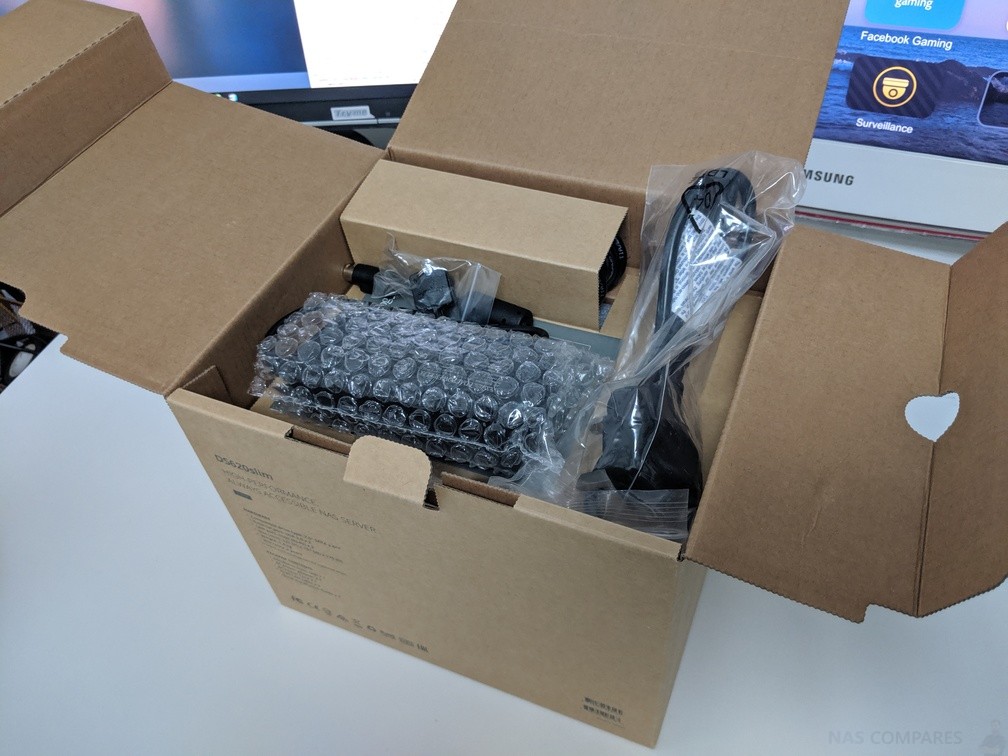
The unit arrives in the typical Synology product packaging and weighs a little over 1.5kg in weight. Even before I unboxed and fully unpacked the DS620slim retail kit, I was impressed by how little this NAS weighed. With its big focus on compact media, that I will touch on later, it is great to see that they have maintained the micro aesthetic even in this six-bay device

- DS620slim NAS x1
- External 65W PSU x1
- Mains Power Connector x1
- RJ45 Cat 5e LAN Cable x2
- Quick Installation Guide x1
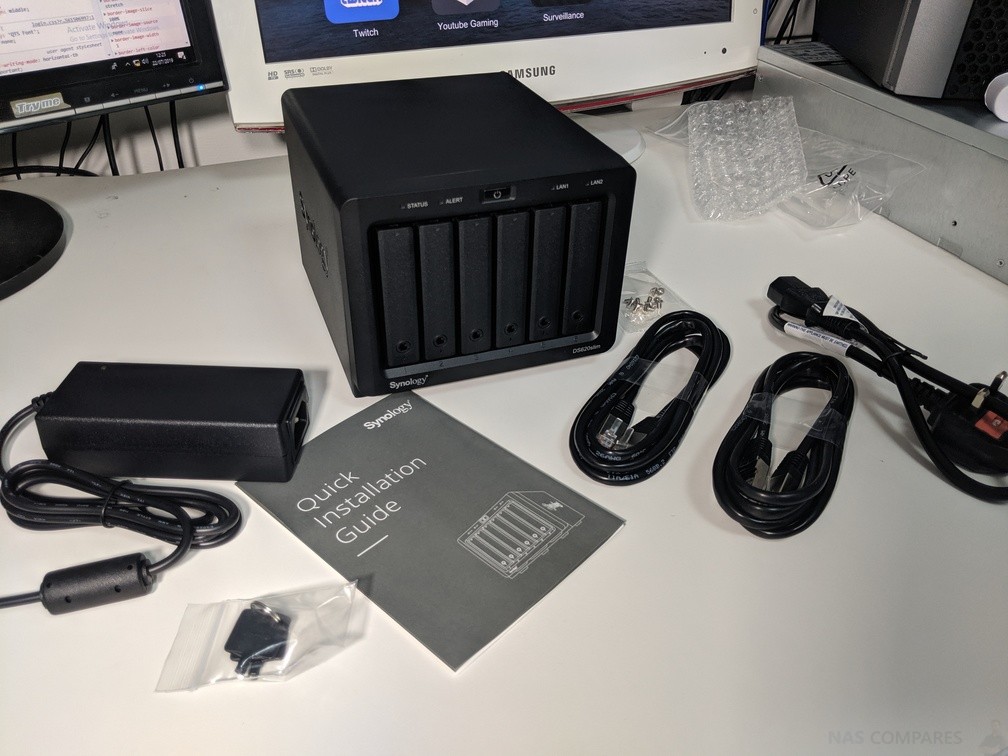
Before we move on to the DS620slim NAS itself, I would like to highlight the PSU that it arrives with. The DS620slim, much like many diskstation NAS devices from Synology, arrives with an external power brick. Despite its large focus on lower energy consumption and a smaller footprint on your physical and network environment, I always approve of an external power brick. Had Synology been tempted to two factors this 65 watt PSU into the design, the chassis would have needed to bulk up, as well as deal with additional temperature factors
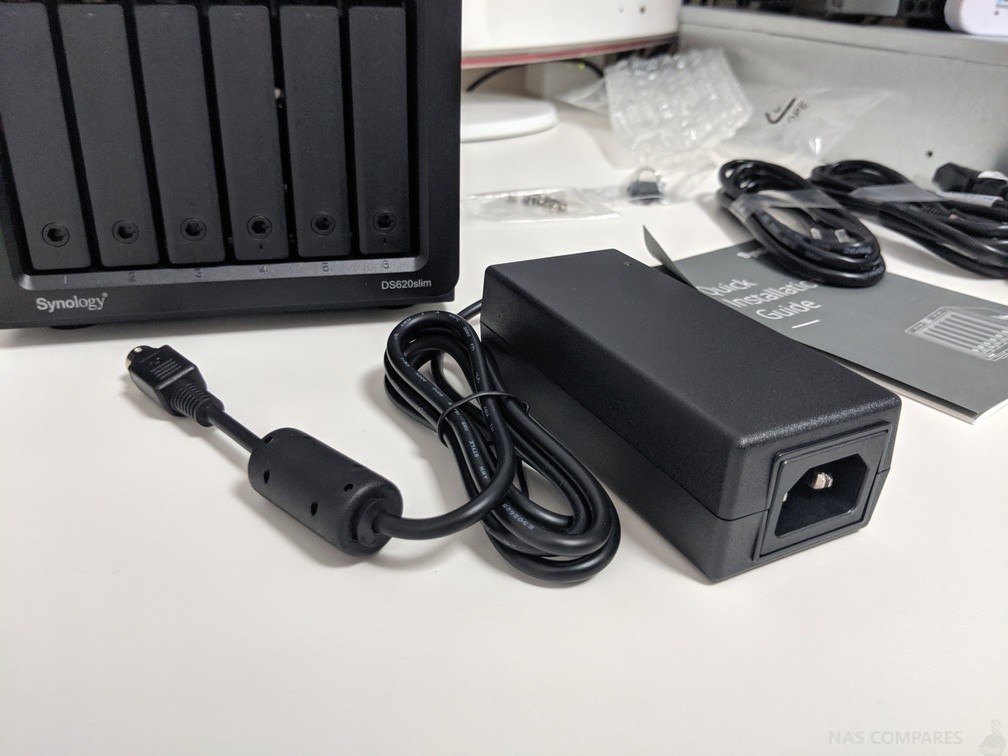
Synology DS620slim NAS – Design
The front of the DS620slim chassis shows us that this NAS is a fantastically scale down copy of bigger diskstation units, such as the DS1618+ and DS3018xs. Though obviously in this scaled-down form, the DS620slim lacks a number of the key physical design elements of those bigger units, it is still a fantastically faithful recreation and provides a number of the design and environmental advantages that Synology have clearly invested in on a design level over the last decade. Measuring it at just 12.1cm x 15.1cmm x 17.5cm and a mere 1.4Kg unpopulated.
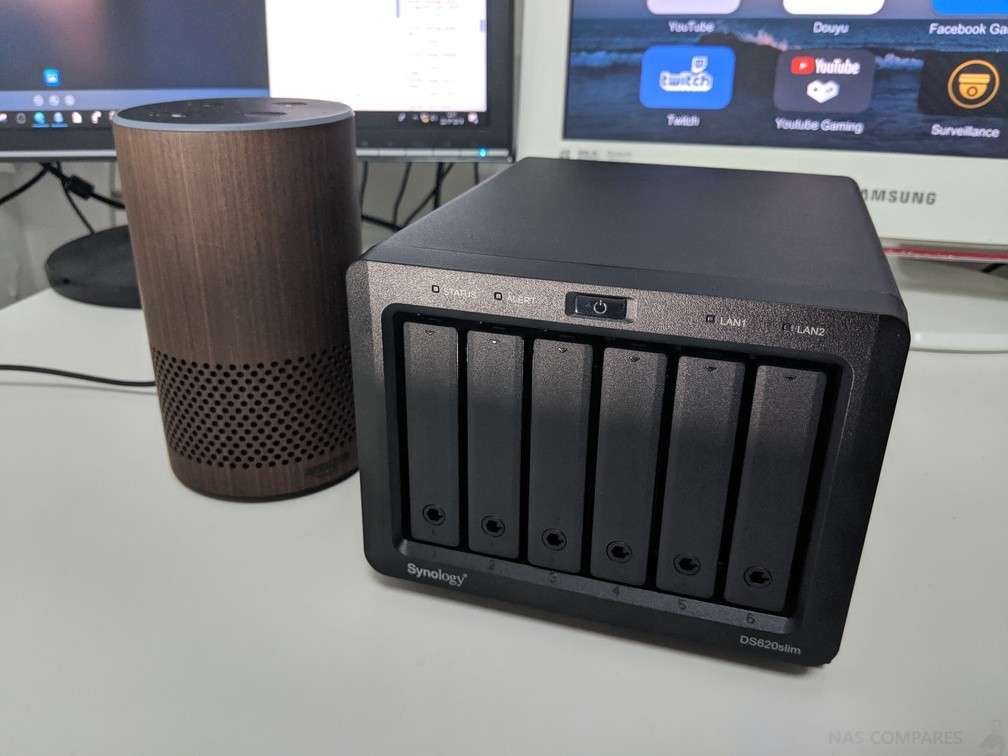
Each individual drive bay can support a 2.5 solid-state drive or hard drive. Though the device can function with a single media drive installed, it is recommended that you install several in the right RAID environment for perfect data redundancy (as well as the performance boosts that the right RAID level can create).
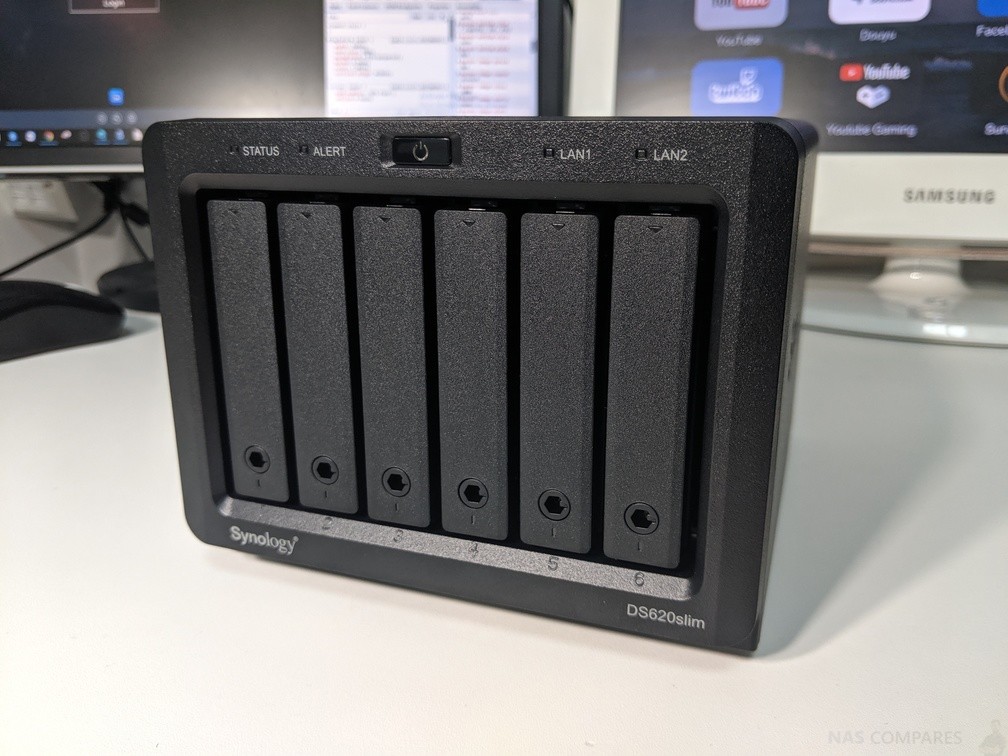
Another cool feature that was confirmed in the later stages of the Synology DS620slim NAS’ development was support for 15mm drives. This means that it supports the very latest 5 terabyte 2.5 inch hard drives, allowing you to take advantage of up to 30TB of raw storage, (or 25 terabytes in a RAID 5 or SHR environment).
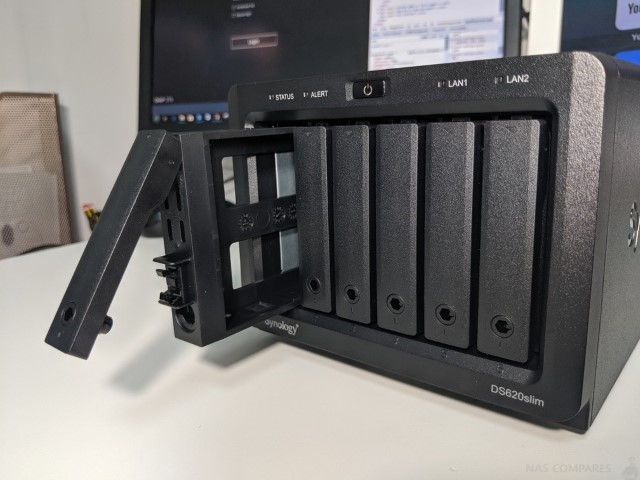
Additionally, it is worth highlighting that the device allows you to use SSD media as raw fast-acting storage that allows the DS620slim to take advantage of that massive throughput internally, or you can use a combination of hard drives for raw storage and 1 to 2 SSDs for caching – providing you with with the best of both worlds of affordable storage and SSD speed performance gains. We will touch on this again later in the review, as I know it is an area of contention for many.
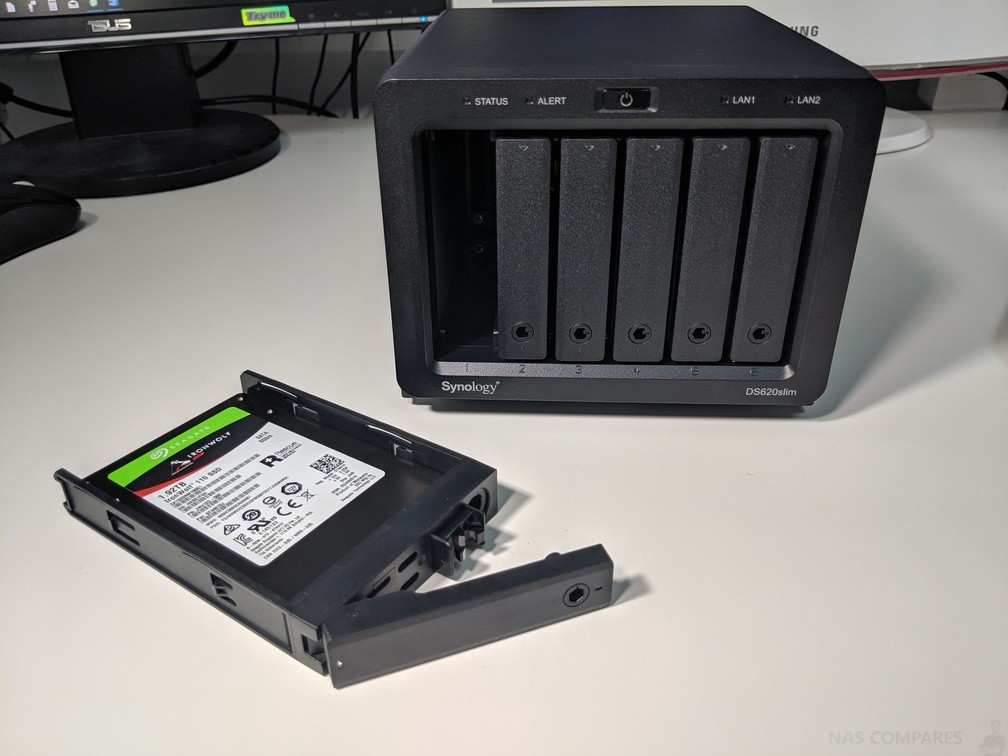
The DS620slim features many typical design elements that have proven very popular in most NAS server devices. Such as the LED indicators located on the front of the device that denotes system access, network activity and individual LEDs for each active drive bay.
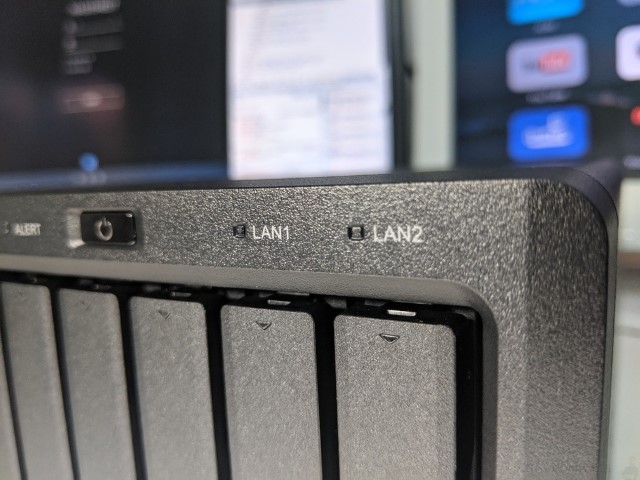
One area where the DS620slim differs in terms of where aesthetic design meets practicality when compared with larger diskstation NAS is in the logo on the side of the chassis. In traditional 3.5 inch hard drive Diskstation NAS, the logo act as both branding and ventilation, as it features a mesh vent panel allowing additional cooling air to pass through the chassis via the rear fan and leave via this mesh panel. Keeping a NAS drive cool is one of the most important parts to maintaining speed and efficiency see, as heat can easily result in hardware functioning slower and opening the door to potential hardware damage in raised temperatures.
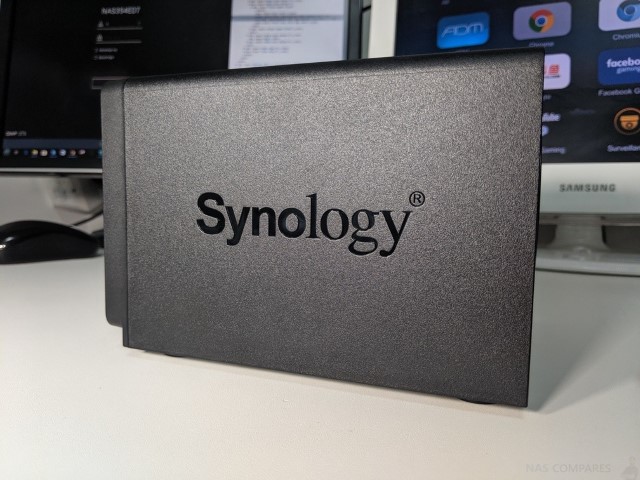
However, the Synology logo found on the sides of the DS620slim chassis has simply embossed symbols and not ventilated in any way. I can see why the ventilation is less necessary in a device that is geared towards compact media and quieter running, but I was still surprised that this long-running design feature was not present.
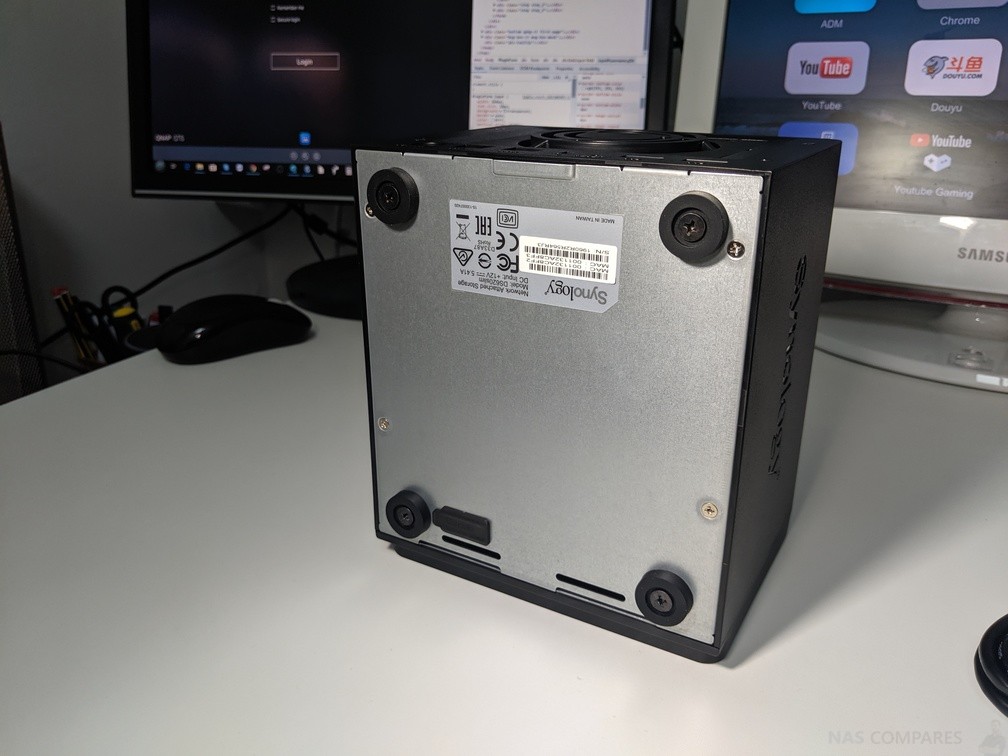
Turning the device upside-down shows us that the base of this chassis merely features four rubberized feet for grounding the device and reducing any vibration. There was minimum ventilation found, but for the most part the base of the DS620slim is quite the blank canvas.
Synology DS620slim NAS – External Hardware
Turning the device around shows us one of the most compact yet reasonably spaced selections of ports and ventilation that I have seen on a Synology desktop NAS drive. it was always going to be tough to provide a multitude of connectivity to this device while still maintaining the DS620slim’s minimalist aesthetic, but they have achieved it for the most part – but not without out the absence of a notable connection.

The rear fan is similar to that of most diskstation NAS devices and is fully controllable from DSM 6.2.2 user interface on your browser or a mobile phone app (DS Finder), and allows you to increase or decrease the RPM as needed.
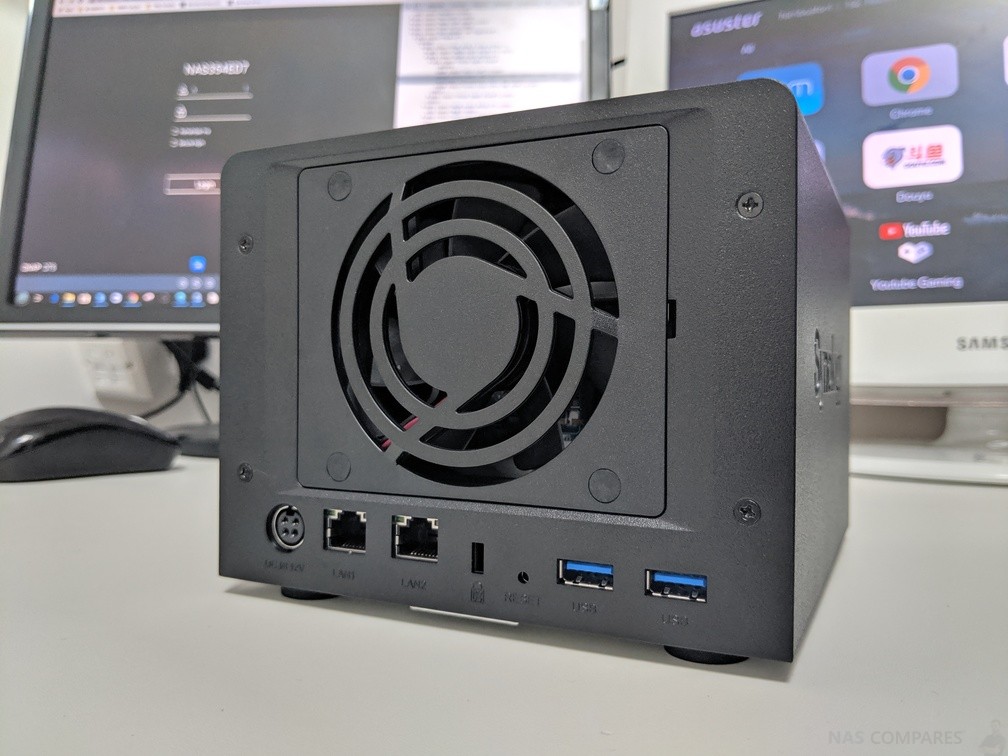
Additionally, the DS620slim features two USB 3.0 ports that can be used for additional storage and backups, connection with UPS and monitoring devices that are supported within DSM, as well as wireless dongles that may well further assist in the compact and discreet nature of set-up that the Synology DS620slim will often find itself deployed within.

In terms of network connectivity, it is here where the Synology DS620slim has and will disappoint some users. With a NAS device that seems exceptionally ready for SSD media, the fact the DS620slim arrives with two 1Gbe LAN connections, and not 10Gbe or a PCIe NIC upgrade option, is a bit of a blow. With that powerful Intel PSU at your disposal, along with up to 6 solid-state drives in a RAID, this could have potentially output well over 1000MB/s per second transmission. Instead, however, you are forced into the bottleneck of 2-gigabit ethernet, and that is only if you utilise link aggregation in which case you are significantly throttling your upload and download speeds to the NAS. This in itself is not the end of the world and most Synology NAS only feature 1, 2 or 4 1Gbe LAN ports, but it is the fact this device is just so, so ready for SSD media that it becomes a bit of a self-imposed glass ceiling.
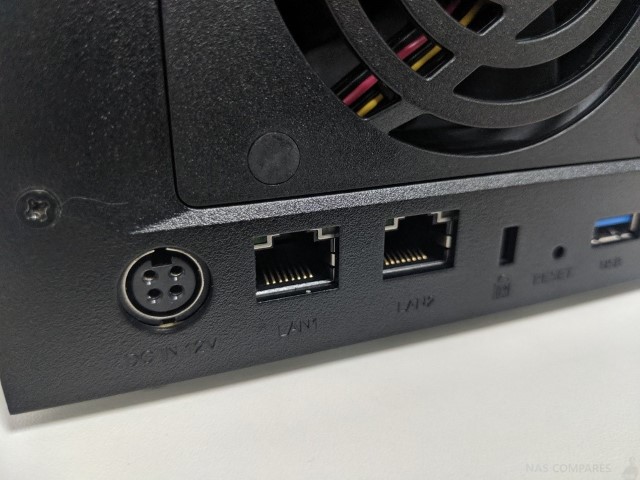
Upload and download speeds between you and your NAS drive should not be the end of the world and in fact, in most cases you are can prioritise increase performance and read-write speed internally when buying a NAS in most cases. It is for this latter reason that Synology has stated that the DS620slim NAS is designed to hold four hard drives for bulk capacity and two SSDs to provide read and write cache to an existing RAID 5 storage away.
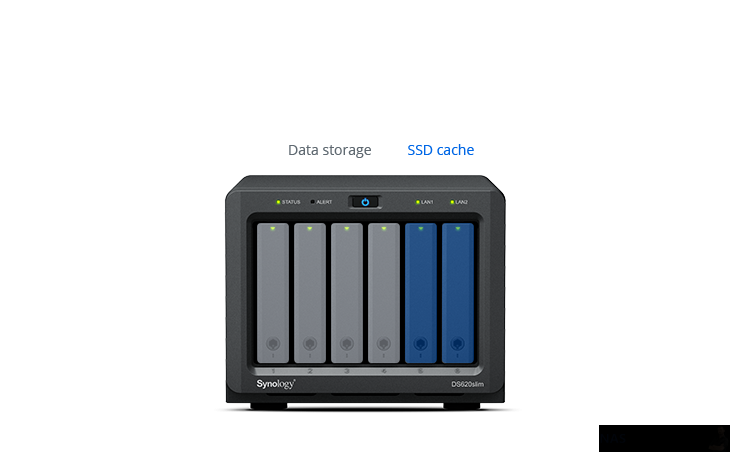
I guess I can see the point and for those looking for a compact and powerful storage array that can be discreetly housed in their home or office environment, this is the best thing Synology has put out there in years. I just think there are users out there who will see all this potential and be held back at purchasing over the 2Gbe limitation externally.
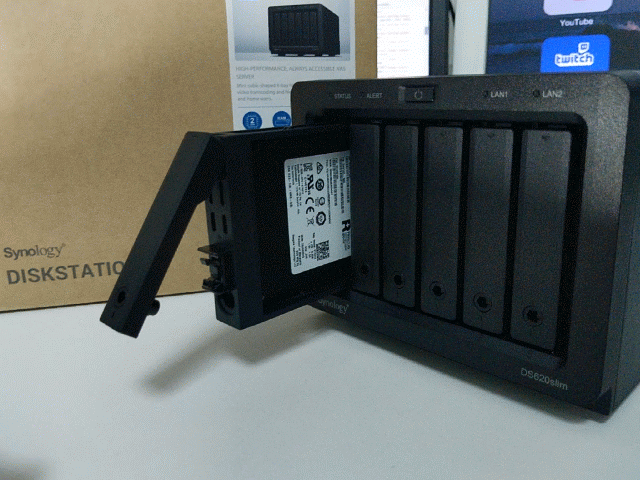
Synology DS620slim NAS – CPU & Memory
One thing that really sets the DS620slim apart from every single other SLIM branded Synology NAS is the hardware under the bonnet! Till now, every single compact value series NAS that they have released have been rather underwhelming supported with Dual-Core 32bit ARM-based processors. This has always made sense in the grand scheme of things, for a low footprint, low impact NAS, you would need a low-end CPU to maintain that level. However, I am pleased to say that Synology has really turned things around on the DS620slim with the impressed and positively established Intel Celeron J3355 2-Core CPU, with a clock speed of 2.0Ghz that can be burst to 2.5Ghz when needed. This is further improved with 2GB of DDR3L memory, that can be officially supported up to 6GB of memory. This is rather an odd figure and the 6GB comprises of 2GB and 4GB of officially Synology memory.
Click to Enlarge
These hardware advantages over the older gen SLIM series mean that not only is it better in terms of read and write speeds over the network than every single one of its predecessors (often struggling with delivering over 80MB/s write over 1Gbe), but can keep up with bigger 3.5″ Diskstation NAS, like the DS1019+ and DS418play in terms of upload and download
Click to Enlarge
However, it is when you start to explore the subject of link aggregation and getting everything that Intel Celeron CPU is capable of that you see the bottleneck that those 2 LAN ports create. As the chart above shows, though the hardware itself is enough to keep up with the other devices over 1Gbe before, it ends up dwarfed in overall performance potential, due to having 2 LAN ports compared with the 4/PCIe slots in the others. This should only be used as a buying factor if you are looking at external speeds as a priority, but still a bit of a shame to cap that great processor so much. Still, this device is focused on its discretion, not its top speed, so I guess we could be more grateful that we see an Intel 64bit x86 CPU in here, rather than a rather simplistic ARM. Though because this device features this more evolved and capable CPU, you will see increased power consumption when fully populated with HDDs compared with the DS419slim (though still drastically lower than other 3.5″ Diskstation NAS) at 34.88 Watts whilst the unit is being accessed and 7.59 Watts whilst in idle/hibernation. Likewise, the larger 6 bay case compared with all the 4 bay SLIM series before it increases the noise level of the DS620slim whilst in full use to 20.5 dB(A) – still remarkably low (especially for 6 Bays), but it’s the first time a SLIM Synology NAS has broken above 18/19db(A)
Synology DS620slim NAS – Software
Support and software of diskstation manager 6.2.2 on the DS620slim NAS is easily more than 80% of all Synology applications, as well as third party programs in their app centre. Support for the popular first-party apps that they have been working on for a number of years is all present here and despite its discreet size, the DS620slim will not disappoint in this area.
- Synology Chat the alternative to Skype communication in your office and internet environment
- Synology Office an alternative to both Microsoft Office applications and Google Docs
- Synology Calendar serving as an alternative to Google Calendar and the Microsoft calendar application
- Synology Drive that serves as a NAS based alternative to the third-party cloud apps Dropbox Amazon S3 and Google Drive
- Synology Moments, the photo cataloguing and facial recognition software that arrived with its own AI component serving as an alternative to Google Photos, Picasa and Facebook albums
- Synology Surveillance Station for IP Camera and Mobile based surveillance supporting upto 25 Cameras
- Plex Media Server, but without transcoding and only upto 720/1080p
- 4K Playback and Native 1080p/4K Transcoding
- Synology Video station
- Synology Photo station
- Free Sugar CRM
- Numerous CMS option
- Synology File Station Management
- Multiple third-party cloud migration tools with Dropbox, Google Drive and more
Synology DS620slim NAS – Verdict
The DS620slim NAS drive from Synology is designed with a specific user in mind and for every 5 people that see the DS620slim, 4 of them will only see its limitations, but (for Synology) it is that one person who will think it is the answer to all of their storage problems. Think of that special pen, that unique spoon in the drawer, that teeny tiny screwdriver in your desk – in most cases, it is not fit for purpose – but it exists for that 1 job it is BRILLIANT at. It is for this reason that Synology tends to create these niche subsection devices in an already fairly niche industry subject as network-attached storage. Every user has a different hardware setup and their storage requirements may well be just as unique. As it stands, the DS620slim is not the NAS that I need in my life right now, although I can think of several times in my career or data storage that a more portable discreet and low-impact server device such as this would have been EXACTLY WHAT I NEEDED. So, if this sounds like a device that you need in your environment, that is because it really is. It is very unique and in many way ones of a kind, so do not hesitate, as it still stands as one of the very best NAS devices for that particularly picky niche of NAS buyer. Maybe not for me, but maybe for you.
| PROS of the DS620slim | CONS of the DS620slim |
|
|
🔒 Join Inner Circle
Get an alert every time something gets added to this specific article!
This description contains links to Amazon. These links will take you to some of the products mentioned in today's content. As an Amazon Associate, I earn from qualifying purchases. Visit the NASCompares Deal Finder to find the best place to buy this device in your region, based on Service, Support and Reputation - Just Search for your NAS Drive in the Box Below
Need Advice on Data Storage from an Expert?
Finally, for free advice about your setup, just leave a message in the comments below here at NASCompares.com and we will get back to you. Need Help?
Where possible (and where appropriate) please provide as much information about your requirements, as then I can arrange the best answer and solution to your needs. Do not worry about your e-mail address being required, it will NOT be used in a mailing list and will NOT be used in any way other than to respond to your enquiry.
Need Help?
Where possible (and where appropriate) please provide as much information about your requirements, as then I can arrange the best answer and solution to your needs. Do not worry about your e-mail address being required, it will NOT be used in a mailing list and will NOT be used in any way other than to respond to your enquiry.

|
 |
Terramaster TOS 7 Preview - Next Gen NAS Ready?
What is QNAP Planning for 2026? Round Up of the QNAP 2025/2026 Event in London
2x 10GbE to USB4 Adapter - DO YOU NEED THIS?
New Gl.iNet Beryl 7, Comet 5G SIM KVM and Flint 3e Value Router Revealed
NEW UGREEN DXP4800 PRO and DXP4800S NAS REVEALED
NanoKVM Pro Review - SO, SO CLOSE TO PERFECT...
Access content via Patreon or KO-FI





Discover more from NAS Compares
Subscribe to get the latest posts sent to your email.


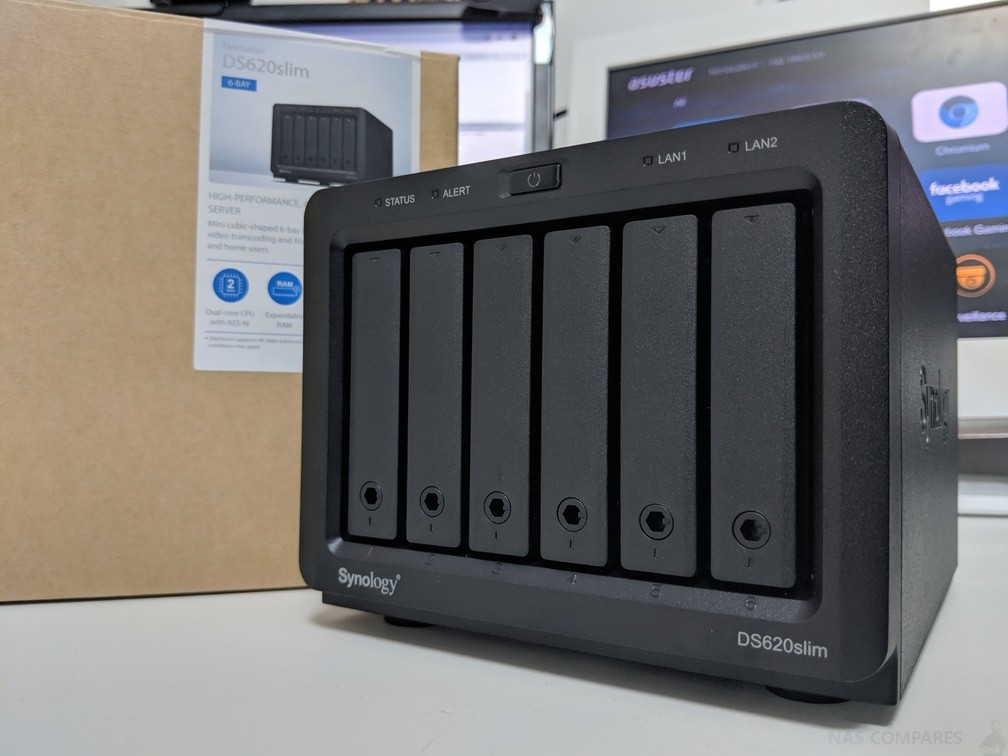





Ciao e abbastanza potente per essere usato come backup per foto e video e trasmettere contenuti multimediali o meglio la versione non slim da 4 gb di ram ? Grazie
REPLY ON YOUTUBE
Dear Synology, make DS625slim, with capable cpu, 8GB of ram (yes, it is not that expensive, as Apple trying to lie) AND !!! at least 1x10gbe. I don’t care, how many 1gbe you trying to throw on us. I don’t want to buy your stupid accessories. This device would be absolutely great for populating with 2,5″ SSDs, always on QUIET nas. Personal cloud, but absolutely silent. And if it can run a VM or two, well, shut up and take my money… It is 2025, full flash home nas is a thing. Terramaster F8, Asustor Flashstore… I would laugh my lungs of if you ever try to create 4 slot nvme only nas with 4x 1gbe. Nobody cares at your 4x 1gbe. Nobody wants to smb multichanel, Everyone wants 1 fast ethernet. Come on. USB 4 is capable of 40gbps. We know what the speed is.
REPLY ON YOUTUBE
Like the idea of this one, do we think a new version may ever come out. Before I pull the trigger
REPLY ON YOUTUBE
What transfer speed are you getting?
REPLY ON YOUTUBE
so you need two lan ports??????
REPLY ON YOUTUBE
Terrible audio!
REPLY ON YOUTUBE
I *REALLY* wish they would update this model with at least 2.5gbe. I want an SSD nas, but 1gbe does not make sense.
REPLY ON YOUTUBE
Seems like 2.5in hdd’s of the spinning platter variety are slowly disappearing. What’s still available isn’t a great value option, which is a shame because filling this with all SSDs is going to be prohibitively expensive at the moment. However, given how the storage industry is evolving, it may end up cheaper and performant for Synology to build a tiny chassis with a bank of nvme slots for this market segment.
REPLY ON YOUTUBE
Any date for an upgrade of this slim unit to be released? Keep the hard work!
REPLY ON YOUTUBE
Nifty little powerhouse, severely constrained by the 1 Gbe NIC’s. Would a 5 Gbe USB dongle work on this model, and if so, what performance would you ± get ? Thanks and love your hard work.
Awesome review. Thanks!
Hi,
Thanks you for this very interesting review.
However, one detail surprises me: on the tenth picture, it’s clear that you are installing a Seagate Ironwolf 110 1.92TB SSD in this NAS. But the DS620slim is not compatible with this SSD (it only works with 240 and 480GB). How did you do?
It is just a test drive. You are right.
You should note in this review that the DS620slim (unlike the DS419slim for example) is not and will never be compatible with 12 V drives (only 5 V). This is a big limitation which really decreases the value of this NAS.